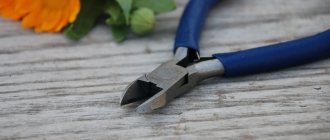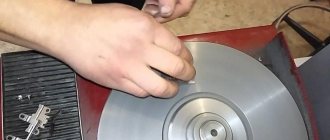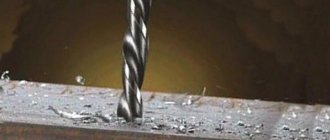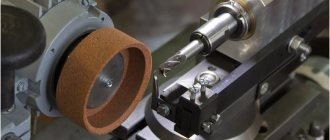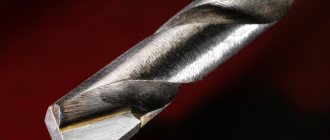Sharpening manicure tools is a very important process. This is especially true for those tools that have just been purchased, because it is not a fact that tweezers, nippers or other manicure tools were carefully sharpened at the manufacturer’s factory. Sharpening is also necessary for those manicure accessories that are used for a long time, since over time they can wear down and become dull. That's why at one point you may need to sharpen your manicure tools.
Rules of care
For manicure accessories to last a long time, they need to be well cared for. It is very important to store your tools correctly. Most often, they become unusable precisely because of improper storage.
Regular and timely care of manicure accessories will ensure their comfortable use and long service life.
- Scissors, wire cutters and tweezers must be stored in special cases , otherwise notches and unevenness may form on their surface. If you don't have a special case, you can wrap them in soft cloth.
- Do not store manicure accessories next to each other , avoid sudden temperature changes and high humidity.
- Place all cutting tools with the blade facing up or on its side .
- Scissors and wire cutters should be oiled .
Methods
A good craftsman can be identified not only by the work performed, but also by the condition of the tools, namely by sharpening. After all, a sharpened tool allows the master to perform his work efficiently and reduces the risk of injuring the client to a minimum. There are two ways to sharpen tools: give them to a professional or sharpen them yourself. Sometimes it is not possible to turn to a professional sharpener due to lack of time, trust or funds, since the procedure is not the cheapest. In this case, you can try sharpening your tools at home.
Signs of a dull instrument
Typically, a blunt tool has jagged edges; sometimes of scissors and wire cutters differ The tips and cutting edges become so thick that it is almost impossible to grip the skin or remove an ingrown toenail.
The frequency of sharpening depends on how often you use the manicure set. Usually the need for it occurs once every 2-6 months .
This video will tell you how to sharpen nail clippers:
Preparatory work before sharpening
Surely housewives have more than once noticed the fact that a dull knife can cut faster than a sharp one. The situation is approximately the same with blunt manicure instruments. Having bought a treasured set in a leather case once, you should not rely on its professional suitability for a long period of time. Even if you use your favorite tweezers exclusively for personal purposes, after 6 months they will become unusable. It is not so difficult to distinguish a tool that requires sharpening; the main thing is to be guided by the following indicators:
- partial tarnishing and speckling on the working surface of the edges;
- change in the density of the metal itself;
- deterioration of the cutting ability of the accessory;
- chips along the length of the working edges, interfering with the process of removing the cuticle.
Have you noticed anything from the list on your instrument? Then we recommend that you start sharpening it without putting the matter in a dark drawer, otherwise you risk the condition of the device being too neglected and after that only a professional grinder who does ultra-strong spraying will be able to help you. The main thing is not to confuse the change in cutting characteristics due to dullness with untwisted play. The backlash is an iron bolt that connects the scissor structure. If it “squirms” and does not sit tightly in the hole, then you just need to “tighten” it using a universal screwdriver.
Well, it's time to choose a material that will help you sharpen your manicure scissors. Of course, if the procedure takes place at home, then it is unlikely that you will find a diamond stone in your arsenal. There is no need to panic, ProstoNail specialists know at least a few more alternatives to this toiletry case:
- sandpaper. Surely every housewife will have a small piece of sandpaper. Sandpaper is easy to maneuver, the main thing is to choose the material with the greatest abrasiveness;
- aluminium foil. Sold everywhere: in supermarkets and household goods, in ordinary local shops and large construction hypermarkets. We are sure that a roll of foil has found its way into your kitchen;
- grindstone. Most likely, the probability of finding it in the apartment of the average city dweller is extremely low, but why not try your luck?
- glass jar. Enterprising beauties do not throw away bottles for preservation, but carefully store them somewhere on the mezzanine. Finally it was their turn. Feel free to take out glass jars with a small neck and get to work;
- pins and/or needles. Such a simple object can be found even in the home of an avid bachelor, let alone girls. A very functional thing, isn't it?
- diamond circle. Last but not least option. This is a classic device that helps to effectively, quickly and efficiently sharpen any steel or metal tool, including cuticle scissors.
Signs of a well-sharpened tool
- Cuts the nail plate, rough skin and cuticle smoothly, with the entire blade, but especially well at the tips.
- Cuts in a thin layer.
- Causes deep deformations.
- Does not tear or pull the skin.
- It runs smoothly and cuts well without pressure.
Appearance of a well-sharpened tool
- The working blades are free from nicks, scratches and stains;
- the tips of the scissors and nippers are thin and equal in length and width;
- the cutting blade is uniform and has no sharp breaks;
- when closed, the cutting blades do not intersect.
Tools that require sharpening
Manicure tongs
Nail clippers are a kind of replacement for manicure scissors. They are also used to shorten nails with a hard nail plate. Nippers differ from wire cutters in size, grip shape and extended blade. When choosing nail clippers, you should pay attention to several details.
- Quality of material. The tongs must be made of stainless steel. This is necessary so that they do not deteriorate during prolonged contact with water. It is advisable to give preference to well-known manufacturers with a good reputation.
- Ideal cutting surface. Under no circumstances buy tongs with gaps, even the slightest. This indicates that the tool is not sharpened correctly.
- Progress. It should not be too tight or too loose, as the quality of work will be reduced and there is also a risk of injury. For example, if the handles bounce sharply, it is easy to get injured.
- Sharpening. The cutting surface must be perfectly sharpened. You can check the sharpening on a thin sheet of paper.
Cuticle nippers
Nippers are a manicure tool that is used to remove excess cuticle, which protects nails from injury and various harmful bacteria. That is why not only the appearance, but also the health of the nails depends on properly trimmed cuticles. Therefore, when choosing wire cutters, there are several things to consider.
- As already emphasized in the description of the tongs, the most important attribute is the material from which they are made. The most practical models are made using special technology from medical stainless steel. They can also be distinguished from other models visually: they have a matte finish. And also such models are more resistant to moisture and other external factors, which helps to increase their service life.
- The cutting surface is of great importance. Under no circumstances should the nippers catch, scratch, or tug the delicate skin of the cuticles. When buying wire cutters, you can test the sharpness on a piece of polyethylene.
- It is very important that the nippers have a comfortable position in your hand. In addition to size, springs play an important role. Today, there are three types of springs for wire cutters: single, double and spiral. Here the type of springs does not matter much, the main thing is that you feel comfortable working with them.
Important! Nippers must undergo a disinfection process after each use.
Tweezers
Tweezers are a tool for manipulating small objects or elements that you do not want to touch with your hands. Tweezers are used in various fields of activity: in medicine, when working with tiny elements, for example, watch repair, when panning for gold, collecting rare items, in cosmetology. Further, tweezers will be considered as a tool for cosmetic manipulations. It has several characteristic features.
- Material. Today, two types of tweezers are known: plastic and metal. Separately, we can distinguish such a variety as automatic tweezers. According to numerous surveys, the fair sex prefers the metal option, citing the fact that it is more durable.
- Form. According to their shape, tweezers can be divided into standard and “scissors”. The standard model is the usual version, consisting of two plates soldered at the top. The “scissors” model got its name from manicure scissors, as they are very similar in appearance. Unfortunately, this model is not particularly in demand. Many simply cannot adapt to it.
- Working surface. There are such options for working surfaces as:
- straight – for working with wide surfaces;
- beveled - great for work, for example, for removing single hairs;
- needle-shaped - used most often in cosmetology and medicine, but sometimes manicurists also use it; it is suitable for placing stones on nails.
Sharpening accessories
Diamond sharpening wheel
You can sharpen manicure accessories in a special workshop or yourself. To do this, you can use a regular fine-grained whetstone or machine . It is advisable to use a diamond-coated grinding wheel . You can buy it at any hardware store or rent it.
You can also use sandpaper . This option will provide a softer and faster sharpening, and it is much simpler than the others. However, such sharpening is short-lived and requires more frequent repetition.
If scissors have curved blades, it is almost impossible to sharpen them yourself. You can only tighten the connecting bolt, and it is better to entrust sharpening to professionals.
To sharpen efficiently, you can take special courses or master classes. It is also advisable to undergo training if you often use manicure tools and they require constant care and sharpening.
Determining the cause of tool malfunction
Often blades lose their functionality not due to dullness, but to the formation of play in the connecting element. In this case, the manicure tool needs repair.
If the wire cutters or scissors do not form an even strip of cutting edges, you need to remove the backlash, which can also be present on new devices when manufactured by an unscrupulous manufacturer.
If there is a connecting bolt on the tool, everything is simple: you need to tighten it using a Phillips or flat-head screwdriver.
If a limiter in the form of a metal pin is used as a fastening element, then you will have to use a hammer and knock it on both sides. When doing this, you need to be careful not to damage the cutting edge.
Types of sharpening
There are different types of sharpening: mechanical and diamond, manual and professional.
Diamond
During factory diamond sharpening, parameters such as sharpness, ideal angles, and convergence of cutting edges are taken into account. This technology allows you to sharpen products that have denser metal in the cutting part, making them more durable and sharp. This sharpening can last for more than a year in home use.
Mechanical
Mechanical sharpening is carried out using mechanical machines. In this case, the master processes each tool manually, giving the necessary sharpening angles, controlling the entire process exclusively by hand. This type of sharpening is simpler and less durable.
Get acquainted with the author's sharpening technology:
Basic rules for sharpening tools
There are several key points that make up the algorithm for servicing manicure equipment. If all points are completed, we get the desired result.
- When closing scissors, forceps or cutters, nothing should prevent the handles from coming together. If such a problem arises during work, they must be taken to the workshop and all interfering or protruding parts must be ground off on the machine. At home, you can do this with a sharpening stone or rasp, being careful.
- Nippers, cutters and scissors should not dangle, there should be no gap between the cutting planes and at the point of connection of the handles.
- The cutting planes of the nippers should be smooth and close without gaps under gentle pressure.
- The convergence of the cutting edges in the nippers should be uniform from one edge to the other, and not wavy: first the tip, and then the heel, or vice versa.
- The blades should not have protrusions or burrs that catch, scratch or cut the skin.
- The outer edge of the pusher should be sharper than the inner one, and the inner one should have a straight line without jagged edges. The main task of the tool is to move the skin, not cut it.
When sharpening, all factors must be met to obtain the desired result.
Sharpening of pliers, skin tongs, tweezers. If the cutters are loose, they are stuffed at the junction of the blades. They should walk softly and close in an even line. The inside of the nippers is ground down to a straight line from the inside. When closing, the blades should be in the same plane, neither higher nor lower than one another. If there are burrs on the tips of the cutters, they need to be sanded down.
Nippers for manicure and pedicure - types, brands, selection criteria and operating rules
Sharpening pushers.
After processing, they should be sharp, but not cut the skin. They should also not scratch the nail. If the pusher falls and bends, the edge is leveled and then ground down. The pusher is always sharpened on the outside, and only polished on the inside. It is necessary to ensure that the outer edges are not sharp; they should also be ground and sanded.
Types of pushers - comparison, characteristics, operating rules
Sharpening nail scissors.
If the blades were deformed after a fall, the edge will have to be ground down. If the damage is significant, then most often the scissors cannot be repaired. If the deformation is small, then grinding helps eliminate it, but the length of the blades will be reduced.
When sharpening scissors, only the front surface is removed. You cannot go into the rear one; it was processed only once at the factory, and this is enough for the entire operating cycle. After each grinding of a layer, it is necessary to remove the metal grain from the blades so as not to damage them when closing.
Nail scissors - types, proper use, choosing the best
The sharpening angle of the scissors must correspond to the factory rake angle and cannot be changed. Usually it is 60-75°.
At the final stage, it is recommended to go over the blades with fine-grained sandpaper to remove burrs.
Sharpening manicure knives.
They are used mainly for pedicures, to remove rough skin and corns. The manicure knife should not be very sharp; the factory angle should be maintained and the edge should not be ground into a bayonet.
How to prepare manicure tools for repair
Before you sharpen a manicure tool, you need to make sure that the problem is in the sharpening and prepare it properly.
Carefully inspect the tool for the presence of center play in the scissors; the axle mount may have become loose. Typically, the axle is a screw or rivet. If a bolt is used, tighten it.
If the screw is already tightened and the blades are still hanging loose, do not bend the blades under any circumstances. This can be corrected by sharpening the limiter, this will allow the blades to be brought closer to each other. Even new cutters sometimes have some play initially. If it is not removed, there will be no correct pressure on the cutting edges, as a result of which the nippers will leave burrs and make poor cuts.
Equipment for professional sharpening
Any master who constantly sharpens manicure tools has special equipment for this. As a rule, only two types of machines are used in this matter:
- Mechanical.
- Laser.
The easiest way to sharpen is on a laser machine, but it also has its drawbacks. With such sharpening, the risk of wear on the blades of the tool increases. During operation, the laser beam greatly removes the thickness of the metal and therefore it becomes brittle.
Sharpening on a mechanical machine is a little more difficult than on the previous one, but, nevertheless, it maintains the strength of the tool and does not shorten its service life.
Manicure is very important for most people and therefore should be taken very seriously. First of all, you should select only high-quality tools for working with nails and take their choice seriously. After all, the health of your nails and skin depends on what tools you use to perform your manicure. That is why it is best to purchase only professional accessories or tools from well-known brands. Well, of course, you need to pay attention to the sharpening of tools in order to ensure comfortable and convenient work.
We recommend visiting our Manicurist Forum , where you can ask questions or chat about interesting topics!
Sharpening at home
Having everything you need, you can sharpen your tools yourself. To do this you need a sharpening stone, sandpaper, and lint-free wipes .
Place the sharpening stone on a flat surface, open the nail scissors or tongs wide and begin sharpening. Movements should be smooth, even, and there is no need to sharpen for a long time. After completing the procedure, the instrument should be wiped with a soft cloth.
The sharpness is checked on a piece of polyethylene: if the tool is well sharpened, the polyethylene should not wrinkle when cut.
It is best to have a sharpening machine with a diamond wheel, which will make your task much easier and keep the tool sharp much longer than sharpening on paper or a whetstone. But such an expensive purchase is only advisable if you do manicure professionally.
How and with what to check the sharpening level
Even a professional manicure cannot be done with a blunt instrument. That is why regular maintenance of tongs, scissors, and tweezers is necessary. With a large flow of clients in the salon, maintenance of scissors and cutters may be required once every two to three weeks. With a lower flow - much less often.
To understand when it's time to sharpen your manicure tools, there are a number of simple tests. They will require the following materials to choose from:
- Thin plastic bag
- Stretch film
- Dried wet wipe made of non-woven material
- Elastic vinyl, latex or nitrile gloves
These same tests will allow you to check the quality of the work performed by the master. In the workshop, these tests are used to check each of the processing stages of blades and cutting edges.
Methods and instructions on how to check the quality and level of sharpening:
- We fix the thin plastic bag so that the edge is even. Unclench the scissors, tongs or wire cutters, place the edge of the bag between them, and close along the entire length. The blades should not tear, snag or pull the polyethylene.
- Stretch film is the most demanding material for checking the level of sharpening. The principle is the same - we fix the film and close the blades along its entire length. The cut should be smooth.
- A napkin made of non-woven material demonstrates well the presence of burrs on metal. With high-quality processing, the cut is smooth, without snagging on the blade.
- Vinyl or nitrile gloves should be secured between the thumb and forefinger, the cutting edges should be completely opened and closed, placing the glove sheet between the blades, and then pulled down slightly towards you. Often scissors or tongs cut well at the base, but the closed edge pulls the glove and tears it. This means it's time to sharpen the blades again.
Tips for using the tool
In order for the manicure set to last as long as possible without the need for repairs, the following important rules should be taken into account during its operation:
- store all tools in separate protective cases;
- never wash them with plain water;
- clean after each use with special products;
- periodically lubricate moving parts with oil;
- use tools strictly for their intended purpose.
The last rule says that nail clippers will need sharpening much earlier if they are intended for cuticles and are used to remove nails, and vice versa.
Each tool has its own function, performing which it brings maximum benefits for the beauty of the handles.
Tool Features
To give a second life to your manicure set, you need to correctly classify it and determine the tools necessary for this. Thus, manual sharpening of nail clippers and tweezers is most often carried out using a needle file, since their cutting blades have a curved shape. If a backlash is formed when they are compressed, then the repair is also supplemented by adjusting the connecting bolt.
After sharpening, the master must polish the tool to smooth out the slightest irregularities and treat everything with a disinfectant.
How to sharpen nail clippers and scissors without a machine
Nippers, tweezers, and scissors are among those tools in the manicure set, without which it is difficult to imagine performing a perfect trimmed manicure or pedicure at home.
The blades of each tool must be sharp, smooth, without gaps in order to efficiently and safely remove the keratinized layer of the cuticle and give the free edge of the nail plate the desired shape. Even professional manicure tools from well-known brands after a while begin to tear off pieces instead of cutting the nails/cuticles evenly. And cutting tools from regular manicure/pedicure kits must be sharpened immediately after purchase. There are three options to solve this problem. Firstly , you can use the services of an individual sharpener who comes to the client’s home and polishes the cutting parts of nippers, tweezers and scissors manually. As a rule, the master works with a diamond monolayer (with a continuous diamond layer) whetstone.
Secondly , you can go to a workshop where a certified specialist will professionally sharpen manicure tools using a diamond wheel or in a special machine. In this case, the services will cost more, but the company provides a guarantee for its work (service life of at least 6-7 months, even with frequent use).
Thirdly , you can turn to the “strong half” of your family for help and sharpening manicure tools at home will save your family budget. You will learn how to properly sharpen scissors and clippers for manicure/pedicure from the photo and video materials in this article.
♦ SHARPENING MANICURE CLIPPERS AT HOME
You can sharpen the blades of the wire cutters using a regular carbon steel file. Choose a file with a uniform grain and close-fitting, fine cuts. We recommend 'experimenting' with old nail clippers, and if you have an expensive professional tool, it is best to seek help from an experienced specialist.
- in the photo: 'cheek', 'heel' and joint (hinge) of the pliers
❶ Backlash. Open the pliers, grab one handle and swing from side to side. If there is play, then place the tool on the workbench, place the rod on the rivet of the hinge joint and tap with a hammer (not too hard), constantly checking the result;
❷ Cleaning the hinge joint. We open the nippers completely and, using a folded piece of sandpaper, clean the joint joints, first on one side of the tool, then on the other;
❸ Sharpening the entire plane of the blade. We place the open cutter with its cheek on the table and with smooth unidirectional movements of the file we grind the inner cutting edge;
❹ Sharpening the corners of the blade. We place the nippers on the cheek parallel to the line of the table edge and with smooth unidirectional movements of the file we grind the corner of the cutting edge;
❺ Sharpening of outer cutting edges. Now you need to close the nippers and place them on the table so that the connected cutting edges are at the top. We grind the outer cutting edges along the connection line using a reciprocating file motion;
❻ Grinding of 'cheeks'. Alternately grind the “cheeks” with unidirectional movements of the file;
❼ Polishing and lubrication. To finish the job, we'll go over the cutting edges of each blade with a polishing stone (8000 grit) to make them smooth and even. After this, you can lubricate the hinge joint with oil.
♦ SHARPENING NAIL SCISSORS AT HOME
For work, prepare two sharpening stones with an abrasiveness of 600 grit and 1500 grit.
— in the photo: joint, cutting edge, side and top plane of the scissors blade.
❶ Backlash. We place the scissors with the sharp edges up, place a small cue ball on the rivet and hit the cue ball with a hammer. We eliminate the play gradually so as not to flatten the rivet too much with one blow;
❷ Lubrication. After eliminating the play, you can lubricate the joint of the tool on both sides so that the blades move freely and smoothly;
❸ Sharpening of blades with 600 grit stone. We fix the open scissors on a stable surface and sharpen the cutting edge from the side of the upper plane of the blade, moving with a 600 grit sharpening stone in one direction (towards you). First we work with one blade, then move on to the second;
❹ Polishing blades with 1500 grit stone. Using a 1500 grit stone, we move in one direction (towards ourselves), eliminating scratches after sharpening and making the cutting edge of each blade smooth;
❺ Blade tips. After sharpening, one tip of the blade may move slightly away from the other. In order for the ends to fit tightly to each other, you need to bend one of them a little with pliers;
❻ Check. Stretch a sheet of printer paper between your fingers and try cutting it down the middle with sharpened scissors. The cut should be smooth, without “chewed” edges.
♦ SHARPENING A MANICURE INSTRUMENT USING A GRINDING WHEEL You can sharpen a tool quickly and efficiently on a sharpening machine. Of course, you should have experience working with such equipment, since you can easily injure your hands while rotating the circle. It is best to sharpen the blades of manicure tools on a fine-grained diamond grinding wheel.
❶ We eliminate backlash at the very beginning of work. To do this, take a strong rod, place one end at the point where the blades join, and tap the other end with a hammer (not too hard), checking the working stroke of the tool from time to time;
❷ First, sharpen the blades from the inside, and then from the outside (taking into account the cutting angle). Set the minimum speed of the diamond wheel in the machine. We move the edge of the blade along a rotating circle in one direction (from beginning to end, contact patch - no more than 0.3 mm);
❸ Turn off the machine, wipe the tool and, using a polishing block with an abrasiveness of 8000 grit, level the edges of the blade, ground in the machine.
♦ HOW TO CHECK THE QUALITY OF SHARPENING?
► Scissors. The cutting surface of the tool after sharpening should be smooth, and the edge of each blade should be even. Be sure to check the movement of the blades and make sure that there is absolutely no play, but the blades close/open smoothly, simultaneously, without unnecessary effort.
Test: Take a sheet of printer paper (or a piece of electrical tape) and stretch it between your fingers. Using sharpened scissor blades, cut the stretched fabric in the middle. If a clear cut remains on the paper without torn or chewed edges, then the tool is ready for use. ► Nippers and cuticle tweezers. Make sure that the edges of the blades on both sides are even and smooth, and that there is no gap between the cutting edges. Take the tool by the handles and move it up/down slightly. If you find any play in the joint of the pliers, be sure to ask the specialist to eliminate it, since during a trimming manicure you can injure the periungual ridges with sharp blades.
Test: Take a piece of thick plastic bag, pull it between your fingers and make a cut with sharpened wire cutters. The edges of the cut should be clear and even.
♦ VIDEO MATERIALS


